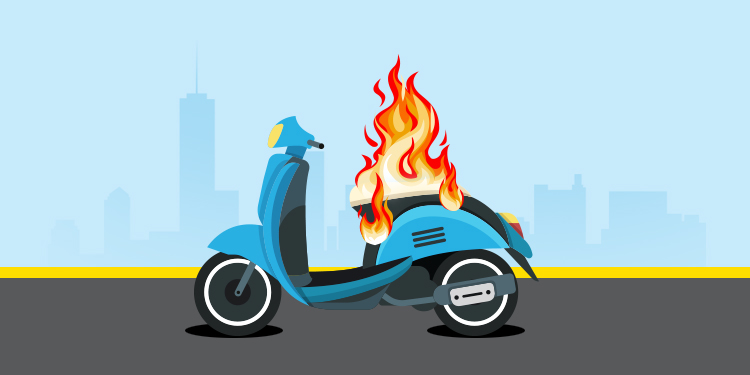The public is watching keenly as electric two-wheelers go up in flames, time and again. It is not just low-speed scooters but even those from high profile brands that have been recalled following untoward incidents. The list includes Ola, Okinawa, PureEV and Hero. In some cases, it is not the vehicle but the charging infrastructure that is to blame, as Hero clarified. Whatever be the reason, an accident creates fear in the mind of a consumer mulling the electric route. Especially ones like the most recent mishap in Secunderabad that claimed eight lives.
A report by strategy consulting firm Redseer Strategy Consultants says that the share of electric two-wheelers is expected to increase to 78 pc by 2030, on the back of government policies, technology, infrastructure and consumer acceptance. A NITI Aayog and Technology Information Forecasting and Assessment Council (TIFAC) report forecasts that the number would be 72pc (with certain incentives withdrawn by 2024 and technological improvements). To place things in context, the over 2.4 lakh electric two wheelers sold in the first half of calendar year 2022 accounted for 3.6 percent of all two wheelers sold.
How will the repeated accidents impact consumer sentiment?

Harish Bijoor, Brand Guru & Founder, Harish Bijoor Consults Inc. says, “The EVs are still considered in a beta testing mode by many. Confidence in the category is low, thanks to all the mishaps we have been reading about.”
According to Business Strategist and Independent Director Lloyd Mathias, the spate of fire-related incidents involving electric two-wheelers is clearly impacting consumer sentiment.
“Only last year there was a lot of hype around electric scooters, with Ola announcing the opening of bookings in August 2021 and over 100,000 scooters booked on the opening day. However, after a series of incidents involving many of the brands like Ola, Okinawa, and PureEV, and the most recent incident of electric scooters catching fire in the basement of a showroom in Secunderabad that killed eight people and injured 11, there are justifiable concerns. Earlier investigations into electric scooters catching fire have identified faulty battery cells and battery modules among the main causes. Social media tends to fan these issues and will naturally deter potential switchers,” Mathias adds.

“Electric two-wheelers are the need of the hour in the auto industry. Hence, incidents like this won’t stop the growth of the sector. But, they can always put forward a few questions by the consumers which need to be addressed by the manufacturers,” observes Atul Gupta, Co-founder and Director, Esprinto.
He distinguishes responsible players addressing safety and consumer concerns from others. “Those players who are not keen on taking care of consumers’ queries, for whatever reasons, are highlighting the electric two-wheeler sector in a bad light. For the time being, the frequent fire incidents will affect the industry. But, for those players who are doing it in the right way, the brand name remains untouched. It is a world-wide phenomenon,” Gupta adds.
The H1 2022 figures show that the top five manufacturers – Okinawa, Hero Electric, Ola, Ampere and Ather – accounted for 76 percent of all e-two wheelers sold in India.

“It is regrettable that there have been so many accidents involving electric two-wheelers, but I don’t believe that this will hinder EV brands’ growth as the sector is still relatively young and has a lot of room for expansion. According to Mr. Amitabh Kant, Indian EV companies are brimming with potential and will revolutionise the sector. I’m confident that we as an industry will be able to prevent accidents through the advancement of technology, as Indian brands have been doing and will continue to do. I’m certain that as long as OEMs and regulators work together, the EV industry will receive the impetus and direction it needs to deliver safe electric vehicles for users in India,” says Samkit Shah, CEO and Co-Founder of Jitendra New EV tech, an EV scooter manufacturer.
What do makers/regulators need to do to allay fears?
Vivek Venugopal, Editor, Quartermile Magazine & Talking Cars, underlines the difference between vehicles priced higher and made by reputed brands and the rest.
“The Indian electric two-wheeler industry has a clear demarcation in the quality of products that are offered. On one hand, we have serious players like Ather, Ola, Bajaj, TVS, etc with their dedicated EV scooters, which cost in the Rs 1 to 1.5 lakh region. These are engineered with better technology and supposedly have higher quality. Their Lithium-ion batteries use the latest chemical composition and use superior construction for cooling as well as dust and water ingress protection.”
He continues, “On the other hand, you also have numerous cheap low-voltage EV scooters whose prices start from under half a lakh rupees onwards. They look like shameless copies of popular scooters like the Honda Dio and the Vespa LX and are sold in unfancy retail outlets, generally in smaller towns. Most of them use smaller motors powered by heavier lead-acid batteries and don’t require licenses, registration, or even helmets to ride. These scooters are often assembled in sheds using Chinese kits, and quality control doesn’t extend beyond the skills of the person who put it all together. An important aspect of any EV is the thermals generated, i.e., how much the battery heats up while riding under load and charging conditions. One manufacturer restricted their sales to just Bangalore for almost a year before they could sell it in Chennai because they were still testing how the battery would cope with the intense heat. And they had to make more changes to the battery management and cooling system before they could sell it to the rest of India, whose temperatures range from the extreme colds of Kashmir to the searing highs of Rajasthan.”
Multiple electric scooter fires – the most recent of them being in Telangana have prompted the government to frame more rigorous safety standards. The AIS156 standard that was set to replace the outdated AIS 048 (from 2009) from 1st October 2022, was amended following the latest accident. It now has specific guidelines on batteries, battery management systems, chargers, water protection and heat propagation due to internal short circuits.
“With the thrust on EVs and demand expected to grow, there is a dire need to develop stringent safety regulations,” observes Mathias. “Policies and standards around safety and clear technology roadmaps are steps that need to be taken by the government,” he adds.
The new standards are expected to raise costs, as the Business Standard reports. It is also expected that there will be an extension for its implementation, as battery makers say the current deadline is impossible to meet for them or testing agencies.
‘Mishaps few, but deter consumers’
While there have been isolated incidents with the big brands, most issues one hears are about low-voltage scooters from relatively unknown brands, notes Venugopal.
“This is an unrestricted sector of the two-wheeler manufacturing industry where scooters are built to lesser standards and are often bought by less informed buyers who simply want a cheaper scooter to beat the fuel prices. These fire incidents could create more awareness and force them to make more informed decisions. Two-wheeler manufacturers with superior technologies are also trying to get people to appreciate their efforts and gain the trust of customers. It will take more time to do so, and it’s safe to assume that a good track record is crucial to their long-term success,” says Venugopal.
Calling for stringent norms, automobile journalist and vlogger Lekshmi C Pillai says, “The recent incidents are really shocking, and they logically cause a bad impact on the EV market. Low-speed scooters, which don’t need any regulation or registration, don’t fall under motor vehicle laws. That also causes untoward incidents, as the government has no supervisory role in their production or usage.”
Irrespective, could the incidents impact perception about electric two-wheelers as a category? It’s a possibility and larger players must address the issue and establish their ‘safe’ credentials, say industry watchers.
“In sheer number terms, the mishaps are small, but in sheer deterrent-image terms, they are big. Consumers and users want to take no risks when making purchases.The EV category needs to work towards offering this. The industry needs to take a safety-first stance before getting excited and wanting to be the first. In this space, the winner is not going to be the first-to-market, but instead it is going to be the last-to-market,” surmises Bijoor.
If cost, range and charging infrastructure were primary considerations earlier, safety could well be the fuel the category needs today.

















